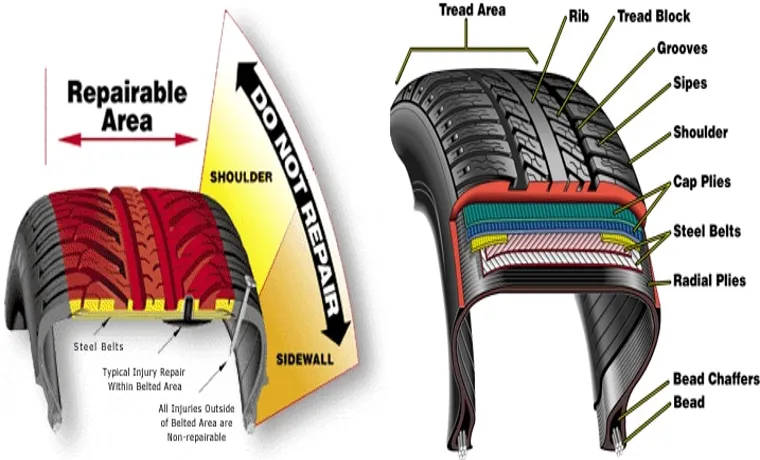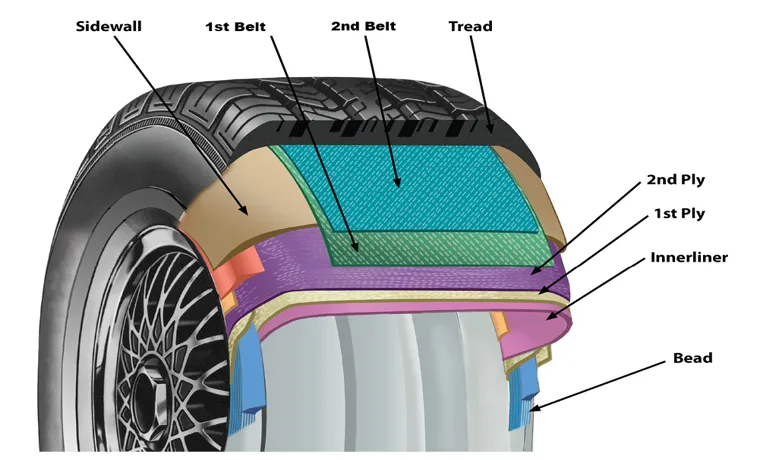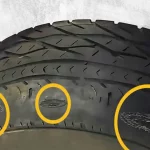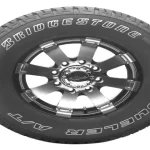Have you ever taken a close look at the shoulder of your car’s tire? While it may not be the most glamorous part of your vehicle, it serves a crucial role in ensuring a safe and smooth ride. Understanding the shoulder of a tire is essential for maintaining your car’s performance and preventing accidents on the road. The shoulder refers to the edge of the tire that meets the sidewall.
This area is exposed to a lot of wear and tear, especially when turning, braking, or accelerating. A damaged shoulder can affect your car’s handling, stability, and fuel efficiency, so it’s vital to check it regularly for any signs of wear, tear, or puncture. The shoulder design can vary greatly depending on the type of tire and its intended use.
Some tires have a rounded shoulder that provides a comfortable ride, while others have a squared shoulder that offers better cornering and traction. Some tires have a staggered shoulder that improves stability and reduces noise, while others have a continuous shoulder that maximizes contact with the road. Choosing the right tire shoulder for your needs can be a matter of personal preference, driving style, and the road conditions in your area.
But regardless of your choice, it’s crucial to maintain your tires properly and replace them when necessary to ensure your safety and the longevity of your vehicle. In this blog post, we’ll explore the shoulder of a tire in more detail, discussing its anatomy, function, types, and maintenance tips. We’ll also address some common questions and misconceptions about tire shoulders and provide some useful analogies to make the topic more relatable and engaging.
Whether you’re a car enthusiast or a regular driver, this post will equip you with the knowledge and skills to make informed decisions about your tires and keep yourself and others safe on the road.
Table of Contents
What is a Tire Shoulder?
Have you ever heard of the tire shoulder? It’s a term used to refer to the area of a tire that extends from the tread to the sidewall. Essentially, it’s the part of the tire that connects the two and allows for a smooth transition between them. The shoulder is an important part of a tire because it helps to provide stability and support, particularly during cornering and turning.
It’s also responsible for directing water away from the tire to prevent hydroplaning, which can be dangerous in wet conditions. Overall, the shoulder of a tire plays a critical role in the overall performance of the tire and should not be overlooked when selecting the right tire for your vehicle. So, next time you’re checking your tires or shopping for new ones, be sure to keep the shoulder in mind!
Definition of a Tire Shoulder
A tire shoulder is an essential term that is commonly used in the automotive industry, describing the outer edge of the tire face where it meets with the sidewall. This portion of the tire shoulder is critical to a vehicle’s overall performance by providing handling, steering, and braking capability. A tire’s shoulder design can significantly impact its grip and traction, especially during cornering or in wet or icy conditions.
The shape and angle of a tire shoulder can also influence a vehicle’s stability, comfort, and noise level. It’s crucial to have a tire shoulder that is properly maintained and free from any damage or irregular wear. Not addressing tire shoulder damage can put the driver’s safety at risk and cause the tire to become less effective over time.
Regular tire maintenance, including tire rotation and proper inflation levels, can help prevent damage to the tire shoulders and prolong the life of the tire.

Why is the Tire Shoulder Important?
Tire shoulder plays a vital role in maintaining the overall performance and safety of your vehicle. But what exactly is a tire shoulder? It is the outer edge of a tire where the tread meets the sidewall. While it may seem like a small and insignificant part of the tire, it is responsible for bearing the weight of your vehicle and providing stability during turns.
A worn or damaged tire shoulder can lead to decreased traction, poor handling, and even blowouts. Moreover, it can affect your vehicle’s fuel economy and make your ride uncomfortable. Therefore, it’s crucial to check your tire shoulders regularly and replace the tires when necessary to ensure proper performance and safety on the road.
Make sure to choose the right tires for your driving needs and maintain them regularly to keep the tire shoulder and the rest of the tire in excellent condition. Not giving your tire shoulder enough attention can ultimately impact your vehicle’s overall performance in more ways than one.
Types of Tire Shoulders
Have you ever wondered what the shoulder of a tire is? Essentially, the shoulder refers to the area where the sidewall meets the tread. There are a few different types of tire shoulders that you should be aware of. First, there is the square shoulder, which is characterized by a 90-degree angle where the tread meets the sidewall.
Square shoulders are common in tires designed for heavy loads and increased stability. Another type of shoulder is the rounded shoulder, which has a smooth curve where the tread meets the sidewall. These tires are designed for improved handling and a smoother ride.
Additionally, there is the tapered shoulder, which has a gradual slope where the tread meets the sidewall. Tapered shoulders are often found on tires designed for wet conditions since they help channel water away from the tire. Whether you’re driving in dry or rainy conditions, understanding the different types of tire shoulders can help you choose the right tire for your needs.
Rounded Shoulder
Rounded Shoulder If you’re in the market for new tires, you may have heard the term “rounded shoulder” thrown around. Rounded shoulder tires have a smooth transition from the tread to the sidewall, creating a rounded contour. There are three different types of tire shoulders: square, rounded, and tapered.
Square shoulders have a flat angle and offer better handling in dry conditions. Rounded shoulders have a more gradual angle and provide better wet traction. Lastly, tapered shoulders have a diagonal angle and offer a balance between dry and wet traction.
When deciding on the type of shoulder you want, consider your driving conditions and style. If you live in a rainy area and prioritize safety, a rounded shoulder tire may be the best choice for you. On the other hand, if you prioritize performance over safety, a square shoulder tire may be the best option.
Ultimately, understanding the different types of tire shoulders can help you make an informed decision when it comes to purchasing new tires for your vehicle.
Square Shoulder
Square Shoulder When it comes to tire shoulders, one type you may encounter is the square shoulder. This type of shoulder has a defined and flat shape, giving the tire a more aggressive appearance. Square shoulders are often found on tires designed for off-road or rugged terrains, as they provide better traction on uneven surfaces.
They are also known for their resistance to wear and tear, as well as their ability to handle heavy loads. However, square shoulders can make for a bumpy and noisy ride on smooth roads, which is why they may not be the best choice for everyday driving. Overall, if you’re planning to do some off-roading or face challenging terrains, a tire with a square shoulder could be just what you need for a safe and smooth ride.
Asymmetrical Shoulder
Have you ever noticed that your tire’s shoulder isn’t completely even on both sides? This is known as an asymmetrical shoulder and it’s actually by design. There are two different types of tire shoulders: the inside shoulder and the outside shoulder. The inside shoulder often has a more rounded shape to improve handling and stability during cornering.
On the other hand, the outside shoulder is usually flatter to enhance traction and decrease braking distances. Tire manufacturers carefully design the asymmetrical shoulder to optimize performance and ensure safety on the road. So, if you’ve ever wondered why your tire looks a little uneven, know that it’s actually intentional and serves a specific purpose.
Functions of the Tire Shoulder
Have you ever wondered what the shoulder of a tire is and what its functions are? Well, the shoulder of a tire is the area found between the tread and the sidewall. It plays an important role in the overall performance of the tire. One of its primary functions is to provide stability to the tire when driving on curves or corners.
The shape of the shoulder helps to distribute the pressure evenly across the tire, reducing the risk of uneven wear and tear. Additionally, the shoulder of the tire helps to improve the vehicle’s handling by providing better traction and grip on the road surface. This is essential when driving in wet or slippery conditions.
The shape of the shoulder also affects the tire’s noise and fuel efficiency. The smoother the shoulder, the quieter the tire will be, and the better the fuel economy. Therefore, it is important to consider the shoulder design when selecting a tire for your vehicle.
Traction
“tire shoulder” The tire shoulder is an essential part of the tire that plays a vital role in providing traction. It is the area of the tire that extends from the sidewall to the tread, and it is responsible for transmitting the vehicle’s weight and forces to the road surface. The shoulder is a crucial part of the tire’s footprint, which is the portion of the tire that contacts the ground.
This contact area translates into traction, and without the shoulder, the tire would have a much smaller contact area, resulting in reduced traction. One of the main functions of the tire shoulder is to provide lateral stability during cornering. When a vehicle turns, the lateral forces transfer to the tire shoulder, where the rubber compounds and design elements are optimized to handle these forces.
The shoulder’s design elements, such as tread blocks and sipes, also provide additional biting edges that help to maintain traction during cornering. Another critical function of the tire shoulder is to provide traction during braking and acceleration. During braking, the tire shoulder comes into contact with the road surface, providing a larger contact patch for better deceleration.
The shoulder’s design, such as a more robust compound and blocky tread pattern, also helps to resist wear and tear during braking. Similarly, during acceleration, the shoulder helps to transmit the vehicle’s power to the road surface, providing essential grip for acceleration and handling. In conclusion, the tire shoulder plays a vital role in providing traction, lateral stability, and resistance to wearing during cornering, braking and acceleration.
A well-designed tire with a robust shoulder can significantly improve a vehicle’s performance and safety on the road surface. Therefore, it is crucial to choose a tire with a well-designed shoulder that is optimized for the intended use and conditions.
Cornering
Cornering on a motorcycle is all about balance, technique, and the functions of the tire shoulder. The tire shoulder refers to the area of the tire that makes contact with the road during cornering, and it plays a crucial role in maintaining traction and stability while leaning into a turn. The functions of the tire shoulder include providing grip, absorbing lateral forces, and distributing weight evenly across the tire.
A well-designed tire with a strong shoulder can make all the difference in how a rider feels while cornering, allowing for more confidence and control on the road. Understanding the functions of the tire shoulder is essential for any motorcyclist looking to improve their cornering skills and stay safe on the road.
Conclusion
So what is the shoulder of a tire, you ask? Well, it’s not just a fancy name for the part of a tire that touches the road. No, the shoulder is the unsung hero of tire design, providing essential stability and grip during cornering and maneuvering. It’s the muscle that flexes and bends along with the rest of the tire, acting as a vital bridge between the pavement and your car’s chassis.
And just like your own shoulders, if the tire shoulder is strong and healthy, you can trust it to support you on any road and in any weather. So don’t overlook the shoulder of your tire – it’s the ultimate wingman on your journey, keeping you safe, stable, and stylish.”
FAQs
1. What is the purpose of a tire’s shoulder? A: The shoulder of a tire is the area between the tire tread and sidewall, and it helps to provide stability during cornering and braking. 2. How can the shoulder of a tire be damaged? A: The shoulder can become damaged due to impacts with potholes or curbs, overloading the vehicle, and improper tire alignment or inflation. 3. Can the shoulder of a tire affect fuel efficiency? A: Yes, worn or damaged tire shoulders can cause uneven wear and reduce fuel efficiency. 4. What are the different types of tire shoulder designs? A: There are various types including rounded shoulders, squared shoulders, and intermediate shoulders. Each design has specific benefits for different driving conditions. 5. How can I check if the shoulder of my tire is worn? A: You can inspect the tire for cracks, bulges, or uneven wear patterns along the shoulder. If any of these are present, it may be time to replace the tire. 6. Can the shoulder design affect noise levels while driving? A: Yes, some shoulder designs can create more road noise than others, so it’s important to consider this when selecting a tire. 7. Is it safe to drive on a tire with a damaged shoulder? A: No, a damaged shoulder can affect the stability and handling of a vehicle, so it is important to have it inspected and repaired or replaced as soon as possible.



